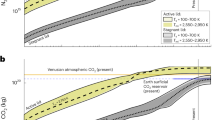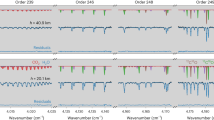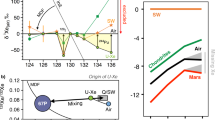Abstract
The ratio of nitrogen isotopes in the Martian atmosphere is a key constraint on the planet’s atmospheric evolution. However, enrichment of the heavy isotope expected due to atmospheric loss from sputtering and photochemical processes is greater than measurements. A massive, multi-bar early CO2-dominated atmosphere and recent volcanic outgassing have been proposed to explain this discrepancy, and many previous models have assumed atmospheric nitrogen rapidly reached a steady state where loss to space balanced volcanic outgassing. Here we show using time-dependent models that the abundance and isotopic composition of nitrogen in the Martian atmosphere can be explained by a family of evolutionary scenarios in which the initial partial pressure of nitrogen is sufficiently high that a steady state is not reached and nitrogen levels gradually decline to present-day values over 4 billion years. Our solutions do not require a multi-bar early CO2 atmosphere and are consistent with volcanic outgassing indicated by both geologic mapping and the atmospheric 36Ar/38Ar ratio. Monte Carlo simulations that include these scenarios estimate that the partial pressure of N2 was 60–740 mbar (90% confidence, with a median value of 310 mbar) at 3.8 billion years ago when the valley networks formed. We suggest that such a high nitrogen partial pressure could have contributed substantially to warming on early Mars.
This is a preview of subscription content, access via your institution
Access options
Access Nature and 54 other Nature Portfolio journals
Get Nature+, our best-value online-access subscription
$29.99 / 30 days
cancel any time
Subscribe to this journal
Receive 12 print issues and online access
$259.00 per year
only $21.58 per issue
Buy this article
- Purchase on Springer Link
- Instant access to full article PDF
Prices may be subject to local taxes which are calculated during checkout



Similar content being viewed by others
Data availability
The data needed to generate all figures in the main text (Figs. 1–3) and Extended Data Figs. 2 and 3 are publicly available at Zenodo (https://doi.org/10.5281/zenodo.5760095).
Code availability
The source code of the nitrogen evolution model and the associated configuration files used in this study are publicly available at Zenodo (https://doi.org/10.5281/zenodo.5760095).
References
Fassett, C. I. & Head, J. W. Sequence and timing of conditions on early Mars. Icarus 211, 1204–1214 (2011).
Robbins, S. J., Hynek, B. M., Lillis, R. J. & Bottke, W. F. Large impact crater histories of Mars: the effect of different model crater age techniques. Icarus 225, 173–184 (2013).
Mathew, K. & Marti, K. Early evolution of Martian volatiles: nitrogen and noble gas components in ALH84001 and Chassigny. J. Geophys. Res. Planets 106, 1401–1422 (2001).
Wong, M. H. et al. Isotopes of nitrogen on Mars: atmospheric measurements by Curiosity’s mass spectrometer. Geophys. Res. Lett. 40, 6033–6037 (2013).
McElroy, M. B. & Yung, Y. L. Isotopic composition of the Martian atmosphere. Science 194, 68–70 (1976).
McElroy, M. B., Yung, Y. L. & Nier, A. O. Isotopic composition of nitrogen: implications for the past history of Mars’ atmosphere. Science 194, 70–72 (1976).
Fox, J. L. & Dalgarno, A. Nitrogen escape from Mars. J. Geophys. Res. Space Phys. 88, 9027–9032 (1983).
Fox, J. L. The production and escape of nitrogen atoms on Mars. J. Geophys. Res. Planets 98, 3297–3310 (1993).
Jakosky, B. M., Pepin, R. O., Johnson, R. E. & Fox, J. L. Mars atmospheric loss and isotopic fractionation by solar-wind-induced sputtering and photochemical escape. Icarus 111, 271–288 (1994).
Zent, A. P. & McKay, C. P. The chemical reactivity of the Martian soil and implications for future missions. Icarus 108, 146–157 (1994).
Fox, J. L. & Hać, A. The 15N/14N isotope fractionation in dissociative recombination of N2+. J. Geophys. Res. Planets 102, 9191–9204 (1997).
Kurokawa, H., Kurosawa, K. & Usui, T. A lower limit of atmospheric pressure on early Mars inferred from nitrogen and argon isotopic compositions. Icarus 299, 443–459 (2018).
Stern, J. C. et al. Evidence for indigenous nitrogen in sedimentary and Aeolian deposits from the Curiosity rover investigations at Gale Crater. Mars. Proc. Natl Acad. Sci. USA 112, 4245–4250 (2015).
Sutter, B. et al. Evolved gas analyses of sedimentary rocks and eolian sediment in Gale Crater, Mars: results of the Curiosity rover’s sample analysis at Mars instrument from Yellowknife Bay to the Namib Dune. J. Geophys. Res. Planets 122, 2574–2609 (2017).
Slipski, M. & Jakosky, B. M. Argon isotopes as tracers for Martian atmospheric loss. Icarus 272, 212–227 (2016).
Hu, R., Kass, D. M., Ehlmann, B. L. & Yung, Y. L. Tracing the fate of carbon and the atmospheric evolution of Mars. Nat. Commun. 6, 10003 (2015).
Song, Y. et al. Quantum-state dependence of product branching ratios in vacuum ultraviolet photodissociation of N2. Astrophys. J. 819, 23 (2016).
Jakosky, B. M. et al. Loss of the Martian atmosphere to space: present-day loss rates determined from MAVEN observations and integrated loss through time. Icarus 315, 146–157 (2018).
Jakosky, B. M. The CO2 inventory on Mars. Planet. Space Sci. 175, 52–59 (2019).
Forget, F. et al. 3d modelling of the early Martian climate under a denser CO2 atmosphere: temperatures and CO2 ice clouds. Icarus 222, 81–99 (2013).
von Paris, P., Grenfell, J. L., Rauer, H. & Stock, J. W. N2-associated surface warming on early Mars. Planet. Space Sci. 82, 149–154 (2013).
Leblanc, F. & Johnson, R. Role of molecular species in pickup ion sputtering of the Martian atmosphere. J. Geophys. Res. Planets https://doi.org/10.1029/2000JE001473 (2002).
Jakosky, B. M. et al. Mars’ atmospheric history derived from upper-atmosphere measurements of 38Ar/36Ar. Science 355, 1408–1410 (2017).
McKay, C. P. & Stoker, C. R. The early environment and its evolution on Mars: implication for life. Rev. Geophysics 27, 189–214 (1989).
Marty, B. & Dauphas, N. The nitrogen record of crust–mantle interaction and mantle convection from Archean to present. Earth Planet. Sci. Lett. 206, 397–410 (2003).
Hirschmann, M. M. & Withers, A. C. Ventilation of CO2 from a reduced mantle and consequences for the early Martian greenhouse. Earth Planet. Sci. Lett. 270, 147–155 (2008).
Bergin, E. A., Blake, G. A., Ciesla, F., Hirschmann, M. M. & Li, J. Tracing the ingredients for a habitable Earth from interstellar space through planet formation. Proc. Natl Acad. Sci. USA 112, 8965–8970 (2015).
Tian, F., Kasting, J. F. & Solomon, S. C. Thermal escape of carbon from the early Martian atmosphere. Geophys. Res. Lett. 36, L02205 (2009).
Marty, B. The origins and concentrations of water, carbon, nitrogen and noble gases on Earth. Earth Planet. Sci. Lett. 313, 56–66 (2012).
Ramirez, R. M. et al. Warming early Mars with CO2 and H2. Nat. Geosci. 7, 59–63 (2014).
Kite, E. S. et al. Methane bursts as a trigger for intermittent lake-forming climates on post-Noachian Mars. Nat. Geosci. 10, 737–740 (2017).
Wordsworth, R. et al. Transient reducing greenhouse warming on early Mars. Geophys. Res. Lett. 44, 665–671 (2017).
Grotzinger, J. et al. Deposition, exhumation, and paleoclimate of an ancient lake deposit, Gale Crater, Mars. Science 350, aac7575 (2015).
Zent, A., Quinn, R. & Jakosky, B. Fractionation of nitrogen isotopes on Mars: the role of the regolith as a buffer. Icarus 112, 537–540 (1994).
Ballou, E. V., Wood, P. C., Wydeven, T., Lehwalt, M. E. & Mack, R. E. Chemical interpretation of Viking Lander 1 life detection experiment. Nature 271, 644–645 (1978).
Nakamura, T. & Tajika, E. Climate change of Mars-like planets due to obliquity variations: implications for Mars. Geophys. Res. Lett. 30, 1685 (2003).
Soto, A., Mischna, M., Schneider, T., Lee, C. & Richardson, M. Martian atmospheric collapse: idealized GCM studies. Icarus 250, 553–569 (2015).
Ribas, I., Guinan, E. F., Güdel, M. & Audard, M. Evolution of the solar activity over time and effects on planetary atmospheres. I. High-energy irradiances (1-1700 Å). Astrophys. J. 622, 680 (2005).
Claire, M. W. et al. The evolution of solar flux from 0.1 nm to 160 μm: quantitative estimates for planetary studies. Astrophys. J. 757, 95 (2012).
Tu, L., Johnstone, C. P., Güdel, M. & Lammer, H. The extreme ultraviolet and X-ray Sun in time: high-energy evolutionary tracks of a solar-like star. Astron. Astrophys. 577, L3 (2015).
Bakalian, F. Production of hot nitrogen atoms in the Martian thermosphere. Icarus 183, 69–78 (2006).
Bakalian, F. & Hartle, R. E. Monte Carlo computations of the escape of atomic nitrogen from Mars. Icarus 183, 55–68 (2006).
Cui, J., Wu, X.-S., Gu, H., Jiang, F.-Y. & Wei, Y. Photochemical escape of atomic C and N on Mars: clues from a multi-instrument MAVEN dataset. Astron. Astrophys. 621, A23 (2019).
Lillis, R., Frey, H. & Manga, M. Rapid decrease in Martian crustal magnetization in the Noachian era: implications for the dynamo and climate of early Mars. Geophys. Res. Lett. 35, L14203 (2008).
Luhmann, J., Johnson, R. & Zhang, M. Evolutionary impact of sputtering of the Martian atmosphere by O+ pickup ions. Geophys. Res. Lett. 19, 2151–2154 (1992).
Fang, X. et al. The importance of pickup oxygen ion precipitation to the Mars upper atmosphere under extreme solar wind conditions. Geophys. Res. Lett. 40, 1922–1927 (2013).
Wang, Y.-C. et al. Statistical studies on Mars atmospheric sputtering by precipitating pickup O+: preparation for the MAVEN mission. J. Geophys. Res. Planets 120, 34–50 (2015).
Leblanc, F. et al. Mars heavy ion precipitating flux as measured by Mars atmosphere and volatile evolution. Geophys. Res. Lett. 42, 9135–9141 (2015).
Leblanc, F. & Johnson, R. Sputtering of the Martian atmosphere by solar wind pick-up ions. Planet. Space Sci. 49, 645–656 (2001).
Barabash, S., Fedorov, A., Lundin, R. & Sauvaud, J.-A. Martian atmospheric erosion rates. Science 315, 501–503 (2007).
Jakosky, B. M. et al. MAVEN observations of the response of Mars to an interplanetary coronal mass ejection. Science 350, aad0210 (2015).
Curry, S. et al. Observations of ICMEs at Mars: past and present. AGU Fall Meeting Abstracts 2018, P51H–-2971 (2018).
Ma, Y.-J. & Nagy, A. F. Ion escape fluxes from Mars. Geophys. Res. Lett. 34, L08201 (2007).
Manning, C. V., Ma, Y., Brain, D. A., McKay, C. P. & Zahnle, K. J. Parametric analysis of modeled ion escape from Mars. Icarus 212, 131–137 (2011).
Bougher, S. et al. Early MAVEN deep dip campaign reveals thermosphere and ionosphere variability. Science 350, aad0459 (2015).
Grott, M., Morschhauser, A., Breuer, D. & Hauber, E. Volcanic outgassing of CO2 and H2O on Mars. Earth Planet. Sci. Lett. 308, 391–400 (2011).
Greeley, R. & Schneid, B. D. Magma generation on Mars: amounts, rates, and comparisons with Earth, Moon, and Venus. Science 254, 996–998 (1991).
Phillips, R. J. et al. Ancient geodynamics and global-scale hydrology on Mars. Science 291, 2587–2591 (2001).
Tanaka, K. L., Robbins, S., Fortezzo, C., Skinner, J. Jr. & Hare, T. M. The digital global geologic map of Mars: chronostratigraphic ages, topographic and crater morphologic characteristics, and updated resurfacing history. Planet. Space Sci. 95, 11–24 (2014).
Bouley, S., Baratoux, D., Paulien, N., Missenard, Y. & Saint-Bézar, B. The revised tectonic history of Tharsis. Earth Planet. Sci. Lett. 488, 126–133 (2018).
Werner, S. C. The global Martian volcanic evolutionary history. Icarus 201, 44–68 (2009).
Gelman, A. et al. Inference from iterative simulation using multiple sequences. Stat. Sci. 7, 457–472 (1992).
Laskar, J. et al. Long term evolution and chaotic diffusion of the insolation quantities of Mars. Icarus 170, 343–364 (2004).
Manning, C. V., McKay, C. P. & Zahnle, K. J. The nitrogen cycle on Mars: impact decomposition of near-surface nitrates as a source for a nitrogen steady state. Icarus 197, 60–64 (2008).
Werner, S. & Tanaka, K. Redefinition of the crater-density and absolute-age boundaries for the chronostratigraphic system of Mars. Icarus 215, 603–607 (2011).
Ivanov, B. A. Mars/Moon cratering rate ratio estimates. Space Sci. Rev. 96, 87–104 (2001).
Hartmann, W. K. Martian cratering 8: isochron refinement and the chronology of Mars. Icarus 174, 294–320 (2005).
Acknowledgements
We thank Y. L. Yung, B. Ehlmann, B. Jakosky, H. Kurokawa, C. Manning, R. Johnson, M. Grott, F. Gaillard, M. Slipski and C.-Y. Ng for helpful discussions. This work was supported by NASA Habitable Worlds grant NNN13D466T, later changed to 80NM0018F0612. The research was carried out at the Jet Propulsion Laboratory, California Institute of Technology, under a contract with the National Aeronautics and Space Administration.
Author information
Authors and Affiliations
Contributions
R.H. designed the study and the evolution model, interpreted the results and wrote the manuscript. T.B.T. implemented the evolution model, carried out the simulations and interpreted the results.
Corresponding author
Ethics declarations
Competing interests
The authors declare no competing interests.
Peer review
Peer review information
Nature Geoscience thanks Ramses Ramirez and the other, anonymous, reviewer(s) for their contribution to the peer review of this work. Primary Handling Editors: Tamara Goldin; Xujia Jiang; Stefan Lachowycz.
Additional information
Publisher’s note Springer Nature remains neutral with regard to jurisdictional claims in published maps and institutional affiliations.
Extended data
Extended Data Fig. 1 A model for the long-term evolution of the free nitrogen reservoir on Mars.
The free nitrogen reservoir is comprised of N2 adsorbed in the regolith and 2 in the atmosphere, and it changes over time due to sputtering loss, photochemical loss, ion loss, volcanic outgassing, and nitrate deposition. The regolith and the atmosphere are assumed to exchange isotopes over geologic timescales driven by the temperature variations due to orbital obliquity changes63. We do not include impact additions or removal because the major impacts should have occurred before the modeled period1,2 (from 3.8 Ga to present). Nor do we include the impact decomposition of near-surface nitrates64 explicitly, as its rate is less than the present-day outgassing and photochemical escape rates by several orders of magnitude (Supplementary Information H).
Extended Data Fig. 2 Representative background CO2 evolutionary scenarios adopted in this study.
These scenarios are selected from the evolutionary tracks of CO2 derived in Hu et al. (2015)16 and they are consistent with the present-day pressure and carbon isotopic composition. Scenarios 1 - 3 assume that the photochemical loss rate of carbon depends on the Sun’s Lyman continuum flux to the power of 2. Scenario 1 assumes that carbonate deposition of 40 mbar occurred throughout the Noachian and Hesperian (that is, till 3.0 Ga) in shallow subsurface aquifers. This represents the lower bound of the initial CO2 partial pressure. Scenarios 2 and 3 assume that carbonate deposition of 290 and 600 mbar occurred in the Noachian and early Hesperian (that is, till 3.5 Ga) in open-water systems. Scenario 3 has an initial CO2 partial pressure of 1 bar and is the default scenario adopted in this study. Scenario 4 assumes a power-law index of 3, and that carbonate deposition of 1400 mbar occurred in the Noachian and early Hesperian (that is, till 3.5 Ga) in open-water systems. This represents the upper bound of the initial CO2 partial pressure. Scenario 5 is an endmember scenario where the CO2 atmosphere is assumed to be collapsed at all times and the pressure constant at 7 mbar.
Extended Data Fig. 3 Baseline crustal production rate adopted in this study.
(a) Crustal production rates derived from the photogeologic analysis of volcanic provinces57 from 3.8 Ga. To convert the photogeological analysis (expressed as the total volcanic emplacement in each geologic period from middle Noachian to late Amazonian) to the crustal production rate, we compare the rates derived using the age boundaries from the crater density65 and the chronology model of Ivanov (2001)66 and Hartmann (2005)67, as well as interpolation methods using either step functions or mid-point averages. The labels show the total volcanic activity and the integrated volcanic activity in the last 2 billion years (in parentheses). The midpoint approach would introduce substantially more total volcanism, and so we use the step-function approach. Also in comparison is a volcanic history derived from earlier photogeologic analyses and used in the recent argon isotope study15. The step-function approach on the Hartmann (2015) chronology leads to a baseline model that is very similar to the one used in the argon isotope study15 in terms of the total and the recent volcanic rates. (b) Baseline crustal production rate adopted in this work, based on the global thermal evolution model56 and the step-function interpolation of the photogeologic analysis of volcanic provinces57, whichever is greater. We adopt the model using the Hartmann (2015) chronology as our baseline model, and consider the one using the Ivanov (2001) chronology as the variant. The two models have appreciable difference in the last 2 billion years.
Extended Data Fig. 4 Posterior distributions of parameters from unconstrained MCMC simulations with the parameters and their boundaries listed in Table 1.
The MCMC simulations adopt the five representative CO2 evolution scenarios shown in Extended Data Fig. 2.
Extended Data Fig. 5 Posterior distributions of parameters from constrained MCMC simulations with the parameters and their boundaries listed in Table 1.
The MCMC simulations adopt the five representative CO2 evolution scenarios in Extended Data Fig. 2.
Extended Data Fig. 6 Posterior distributions of parameters from constrained MCMC simulations that fix the sputtering multiplier to be fsp=0.5, 1, and 2.
These simulations adopt the CO2 evolutionary scenario No. 3 with the initial partial pressure of 1.0 bar as shown in Extended Data Fig. 2. The initial partial pressure of N2 is more tightly constrained when the sputtering multiplier is fixed.
Supplementary information
Supplementary Information
Supplementary Information A–H, figures and tables.
Rights and permissions
About this article
Cite this article
Hu, R., Thomas, T.B. A nitrogen-rich atmosphere on ancient Mars consistent with isotopic evolution models. Nat. Geosci. 15, 106–111 (2022). https://doi.org/10.1038/s41561-021-00886-y
Received:
Accepted:
Published:
Issue Date:
DOI: https://doi.org/10.1038/s41561-021-00886-y
This article is cited by
-
Photochemical depletion of heavy CO isotopes in the Martian atmosphere
Nature Astronomy (2023)



